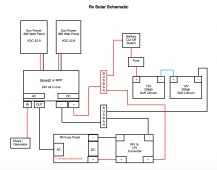Hello Everyone,
I have researched several other posts here as well as a good bit of video (Will Prowse) and come up with the following system AND a few questions that I couldn't find answers to or my brain couldn't process (possible information overload). My wife and I just sold our current RV and travel to California in a few weeks to get our new one and have to put solar in first thing as we are full timers and need POWER! lol
MPP or Growatt 24V 3k all in one
Question 1 - Mounting of All in one
A. Can these be mounted inside the storage compartment of an RV? I've seen people use a metal backing due the instructions mentioning heat.Putting a piece of metal on the carpet interior seems like it would just transfer the heat? Also I imagine the inside of an RV storage compartment ca get pretty hot. Is there an operating temperature to worry about?
B. Can they be mounted sideways?
I am looking at putting on two large panels, 390 watts each, wired in parallel for shade issues.
Question 2 - PV Breaker / All in one inputs
I was told with just the two panels I didn't need one. Do I a breaker and if so what specs? Also do I need a breaker due to there only being 1 input on the All in one systems or is there a part that combines the 2 wires down to 1 and if so what's that "technically called"
Question 3 - Can someone recommend tall brackets that will mount those solar panels on top of the RV with room to clear the vents fans and skylights?
I'm looking to run TWO SoK 206ah Lithium batteries (or equivalent) in series to make 24v
Question 4 - What Size accessories do I need
Battery Fuse size? I think a 300amp
Busbar size? I have no clue tbh. is there an equation or reference for this?
24V to 12V Buck step down? Is 40amps enough, not sure how this is figured
Wiring Diagram
I basically took someone else similar one off of this webpage. I'm trying not to ask the same questions everyone has every week.
A. Does it look correct?
B. If I added a battery monitor with shunt where does that go in the diagram? On my current set up it's just off the negative busbar (see picture)
Thanks in advance and sorry as I'm sure I've asked questions already asked before
I have researched several other posts here as well as a good bit of video (Will Prowse) and come up with the following system AND a few questions that I couldn't find answers to or my brain couldn't process (possible information overload). My wife and I just sold our current RV and travel to California in a few weeks to get our new one and have to put solar in first thing as we are full timers and need POWER! lol
MPP or Growatt 24V 3k all in one
Question 1 - Mounting of All in one
A. Can these be mounted inside the storage compartment of an RV? I've seen people use a metal backing due the instructions mentioning heat.Putting a piece of metal on the carpet interior seems like it would just transfer the heat? Also I imagine the inside of an RV storage compartment ca get pretty hot. Is there an operating temperature to worry about?
B. Can they be mounted sideways?
I am looking at putting on two large panels, 390 watts each, wired in parallel for shade issues.
Question 2 - PV Breaker / All in one inputs
I was told with just the two panels I didn't need one. Do I a breaker and if so what specs? Also do I need a breaker due to there only being 1 input on the All in one systems or is there a part that combines the 2 wires down to 1 and if so what's that "technically called"
Question 3 - Can someone recommend tall brackets that will mount those solar panels on top of the RV with room to clear the vents fans and skylights?
I'm looking to run TWO SoK 206ah Lithium batteries (or equivalent) in series to make 24v
Question 4 - What Size accessories do I need
Battery Fuse size? I think a 300amp
Busbar size? I have no clue tbh. is there an equation or reference for this?
24V to 12V Buck step down? Is 40amps enough, not sure how this is figured
Wiring Diagram
I basically took someone else similar one off of this webpage. I'm trying not to ask the same questions everyone has every week.
A. Does it look correct?
B. If I added a battery monitor with shunt where does that go in the diagram? On my current set up it's just off the negative busbar (see picture)
Thanks in advance and sorry as I'm sure I've asked questions already asked before




